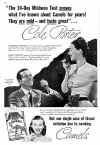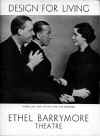Our Love is Here To Stay V
Musical Closets: Gay Songwriters
by John Kenrick
(Copyright 1996, last revised 2008)
(All the images below are thumbnails – click on them to see larger versions.)
Musical Closets
Gay men played a major role in creating the stage and screen musicals of the 1930s and 40s. Leading private lives in publicity-crazed environments required tenacity and courage. I offer three classic examples. Cole Porter and Noel Coward illustrate how gay men could survive and thrive, while Lorenz Hart shows how unhappiness could lead gays to self destruction. All three are examples of how gay men in 20th Century show business overcame a repressive environment by using their "talent to amuse."
Cole Porter
 Cole
Porter and his Kiss Me Kate star Patricia Morrison appeared in a 1948
cigarette ad – the manufacturers of cancer sticks tried to
give their product a touch of class by associating with one of high society's
most renowned homos.
Cole
Porter and his Kiss Me Kate star Patricia Morrison appeared in a 1948
cigarette ad – the manufacturers of cancer sticks tried to
give their product a touch of class by associating with one of high society's
most renowned homos.
Born the grandson of an Indiana millionaire in 1891, Cole Porter was encouraged by his doting mother. He was sent to the finest schools, including Yale and (briefly) Harvard Law School. Like many other young gay men of his class, Porter learned how to keep up a proper front for his family while clandestinely indulging his sexual preferences. He also found that his witty songs (including football fight anthems still used at Yale) made him as popular as any athlete – and he liked the attention. There have been many books written about Porter, but William McBrien's Cole Porter: A Biography (Knopf: NY, 1998) deserves special credit for taking a frank yet responsible look at this brilliant composer's complex personal life.
Cole promoted the legend that he fought in World War I, but that is most likely pure fiction. After serving as a part time volunteer behind the lines, he met wealthy American socialite Linda Lee Thomas. The survivor of a physically abusive first marriage, Linda was happy to overlook Porter's sexuality in exchange for his witty companionship and a share in his glamorous life. He in turn found in Linda the sophisticated, protective life partner he needed, with a personal fortune even greater than his own. The Porters married in 1919, maintaining a joint social calendar but separate bedrooms. Although their union had its rocky moments and occasional break-ups, Cole and Linda remained, in their own way, devoted to each other. Linda's patience was extraordinary, and Cole knew how put that patience to the test.
After a brief, frustrating affair with ballet star Boris Kochno in 1925, Porter limited his sex life to emotionless encounters with sailors and prostitutes. He found that sex, like other pleasures, could be far less complicated when it was purchased. Porter's old friend Monty Woolley often joined him to cruise New York City's waterfront bars and bordellos. The male prostitutes and lower-class tricks they picked up in these places were not likely to talk and would not be believed if they did. The two friends were usually successful in their quests for fresh diversion, at least in part because of their boldness. One night, a young sailor they drove up to on the street asked outright, "Are you two c**ksuckers?" Wooley smiled and said, "Now that the preliminaries are over, why don't you get in and we can discuss the details?"
After Cole discovered the hedonistic lifestyle of Hollywood, his pool parties and gay escapades became so outrageous that Linda left him for several years. She returned when a horse riding accident shattered Cole's legs. In his later years, Porter had several relationships with handsome younger men, but none of these ever eclipsed his relationship with Linda. He limited his sexual encounters to young men who accepted payment in return for their silence. If they spiced things up with a little verbal abuse, Porter found it all the more diverting.
Porter became a center of the social whirl wherever he went, particularly among the homosexual elite. He was the only person who ever threatened director George Cukor's pre-eminence in Hollywood's gay circles. In George Cukor: A Double Life (St. Martin's: NY, 1991), biographer Patrick McGilligan writes that these competing world-class egos were called "the rival Queens of Hollywood," but concedes that "Porter's was perhaps the more privileged invitation."
While Cole kept his sex life a private matter, he had no qualms about using homosexual references in his work. But, as with almost everything else, he did it with singular style.
In the "coded" years, Cole amused himself by pitching his words on two levels, so that the "coach party" audience was content with the obvious, while the "in" group relished the real meaning.
- Graham Payne, My Life With Noel Coward (New York: Applause Books, 1994), p. 5.
A classic example – Porter's lyric for "A Picture of Me Without You" from Jubilee (1935) includes "picture Central Park without a sailor." To the average audience member, this was a harmless line, but "in" group knew this referred to The Ramble, a heavily wooded section of the park where gays cruised willing straight men. When Linda died in 1954, much of the spark seemed to go out of Cole's life. He continued to have serious crushes, but illness made him a semi-recluse in the years leading up to his death in 1964.
For more on Porter's life and career, see William McBrien's Cole Porter: A Biography (Knopf: New York, 1998).
Noel Coward
 Alfred Lunt, Noel Coward and Lynn
Fontanne on the original Broadway cast Playbill cover for Design for Living.
The bisexual theme of the play is hinted at in the photo.
Alfred Lunt, Noel Coward and Lynn
Fontanne on the original Broadway cast Playbill cover for Design for Living.
The bisexual theme of the play is hinted at in the photo.
Despite his polished, high toned image, Noel Coward came from the British lower middle class. Raised in genteel poverty, he was a self-made success and felt his sexual preferences were his private business. However, he couldn't resist the occasional opportunity to tweak society's hypocritical nose. During a television interview in 1956, famed journalist Edward R. Murrow asked if Coward did anything to relax, to which Noel responded, "Certainly, but I have no intention of discussing it before several million people!"
Coward never did anything to promote a false heterosexual image. When tabloid journalists started rumors that he was planning to marry longtime friend Marlene Dietrich (herself a bisexual), he enjoyed a good laugh, let the gossip run its course and continued to live as he wished. Coward enjoyed many sexual liaisons from the age of 12 into his senior years. His tastes ran to sleek, handsome men, and it did not matter if they were chorus boys or royal princes. However, he was the first one to admit that romance was his downfall – he was "no good at love."
For example, Coward had a long term affair with John Wilson, an American stockbroker who exploited the relationship for personal gain. Coward overlooked Wilson's alcoholism and stealing for years. In time, Wilson went too far, leaving Coward open to criminal tax charges. When Wilson married in an attempt to spite Noel, Coward attended the ceremony and entertained a close friend with bawdy lyrics questioning whether the bride or the groom would need lubrication for the wedding night. When the new Mrs. Wilson discovered what a headache she had married, Coward became her sympathetic confidante.
In the 1940s, Coward fell in love with Graham Payne, a handsome young actor who Coward tried to turn into a star. But the good-natured Payne lacked the necessary drive, a fact it took Coward years to admit. Payne admits that they both strayed on occasion, but their mutual devotion lasted for the remainder of Coward's life.
More on Coward and the life of Larry Hart just ahead . . .
